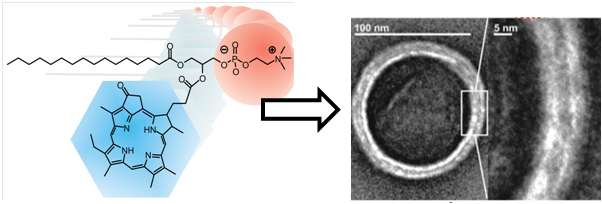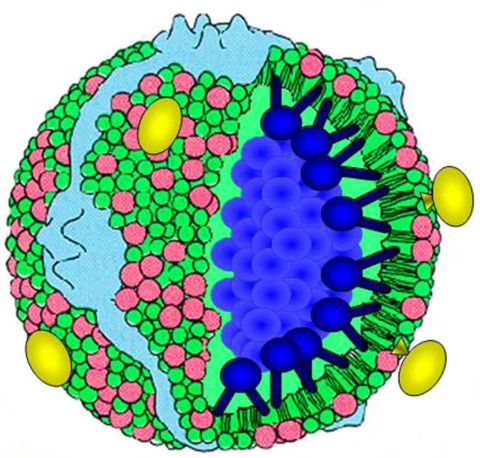Research
The Zheng lab is working tirelessly to develop clinically transferrable nanotechnologies which could open up new possibilities in the fight against cancer. Here, in International Innovation*, Dr. Zheng talks in detail about his current projects.
 We have recently discovered the first all-organic nanoparticle with intrinsically multimodal biophotonic properties (Nature Materials 2011). These particles, coined "porphysomes", are bilayer nanometer-scale vesicles self-assembled from a single porphyrin-lipid conjugate. The very high porphyrin packing density results in structure-dependent "super"-quenching, which, in turn, gives photothermal and photoacoustic properties that are unprecedented for organic nanoparticles. We have demonstrated that porphysomes can efficiently ablate tumor via photothermal therapy and some of the thermal energy generated by porphysomes can be used to create acoustic waves to enable photoacoustic detection of sentinel lymph node. Like liposomes, the large aqueous core of porphysomes could be passively or actively loaded. Upon porphysome bilayer dissociation, fluorescence could be restored to enable real time imaging of drug release. As porphyrins are natural high-affinity metal chelators, we have also gone beyond biophotonics and turned porphysomes into PET and MRI probes. Porphysomes are fully biodegradable and are nontoxic to mice at a very high dose (1000mg/kg i.v.). The biocompatibility, simplicity and intrinsically multimodal nature of porphysomes not only confer high potential for clinical translation but also represent a novel approach to the design of multifunctional nanoparticles as highlighted in "One nanoparticle to rule them all"(Nature Methods 2011).
We have recently discovered the first all-organic nanoparticle with intrinsically multimodal biophotonic properties (Nature Materials 2011). These particles, coined "porphysomes", are bilayer nanometer-scale vesicles self-assembled from a single porphyrin-lipid conjugate. The very high porphyrin packing density results in structure-dependent "super"-quenching, which, in turn, gives photothermal and photoacoustic properties that are unprecedented for organic nanoparticles. We have demonstrated that porphysomes can efficiently ablate tumor via photothermal therapy and some of the thermal energy generated by porphysomes can be used to create acoustic waves to enable photoacoustic detection of sentinel lymph node. Like liposomes, the large aqueous core of porphysomes could be passively or actively loaded. Upon porphysome bilayer dissociation, fluorescence could be restored to enable real time imaging of drug release. As porphyrins are natural high-affinity metal chelators, we have also gone beyond biophotonics and turned porphysomes into PET and MRI probes. Porphysomes are fully biodegradable and are nontoxic to mice at a very high dose (1000mg/kg i.v.). The biocompatibility, simplicity and intrinsically multimodal nature of porphysomes not only confer high potential for clinical translation but also represent a novel approach to the design of multifunctional nanoparticles as highlighted in "One nanoparticle to rule them all"(Nature Methods 2011).
Reposted with permission from Journal of Visualized Experiments
Jin, C. S., Lovell, J. F., Zheng, G. One Minute, Sub-One-Watt Photothermal Tumor Ablation Using Porphysomes, Intrinsic Multifunctional Nanovesicles. J. Vis. Exp. (79), e50536, doi:10.3791/50536 (2013). Lipoprotein-like nanocarriers are a novel class of biocompatible, biodegradable and multifunctional
nanoparticles based on chemically modified lipoproteins (LDL or HDL) or artificially engineered lipoprotein-mimetic nanoscaffolds.
They are specifically designed to address some common hurdles that limit many nanodevices from translating into the clinics.
First, through a network of amphipathic alpha-helix-lipid interactions these nanoparticles offer exquisite size control at the ideal size
range (large enough to avoid renal clearance and small enough to mitigate reticuloendothelial system uptake) thus improving particle circulation
kinetics and delivery efficiency.
Second, we introduced several simple and versatile targeting strategies to deliver these lipoprotein-like nanoparticles
to any receptor of choice (e.g., epidermal growth factor receptor) thus overcoming the narrow purview of lipoprotein receptor-relevant diseases.
Therefore, this technology offers the unique ability to ''tailor'' these nano-beacons in terms of their functional payloads
(imaging -- magnetic resonance imaging and optical probes; therapy -- PDT agents, drugs and siRNAs) and targeting ligands
(e.g., peptides, aptamers, antibodies, etc.) for personalized treatment and diagnosis of cancer and other diseases.
Lipoprotein-like nanocarriers are a novel class of biocompatible, biodegradable and multifunctional
nanoparticles based on chemically modified lipoproteins (LDL or HDL) or artificially engineered lipoprotein-mimetic nanoscaffolds.
They are specifically designed to address some common hurdles that limit many nanodevices from translating into the clinics.
First, through a network of amphipathic alpha-helix-lipid interactions these nanoparticles offer exquisite size control at the ideal size
range (large enough to avoid renal clearance and small enough to mitigate reticuloendothelial system uptake) thus improving particle circulation
kinetics and delivery efficiency.
Second, we introduced several simple and versatile targeting strategies to deliver these lipoprotein-like nanoparticles
to any receptor of choice (e.g., epidermal growth factor receptor) thus overcoming the narrow purview of lipoprotein receptor-relevant diseases.
Therefore, this technology offers the unique ability to ''tailor'' these nano-beacons in terms of their functional payloads
(imaging -- magnetic resonance imaging and optical probes; therapy -- PDT agents, drugs and siRNAs) and targeting ligands
(e.g., peptides, aptamers, antibodies, etc.) for personalized treatment and diagnosis of cancer and other diseases.
*International Innovation, published by Research Media, is the leading global dissemination resource for the wider scientific, technology and research communities, dedicated to disseminating the latest science, research and technological innovations on a global level. More information and a complimentary subscription offer to the publication can be found at: www.researchmedia.eu
Porphysome Nanotechnology
 We have recently discovered the first all-organic nanoparticle with intrinsically multimodal biophotonic properties (Nature Materials 2011). These particles, coined "porphysomes", are bilayer nanometer-scale vesicles self-assembled from a single porphyrin-lipid conjugate. The very high porphyrin packing density results in structure-dependent "super"-quenching, which, in turn, gives photothermal and photoacoustic properties that are unprecedented for organic nanoparticles. We have demonstrated that porphysomes can efficiently ablate tumor via photothermal therapy and some of the thermal energy generated by porphysomes can be used to create acoustic waves to enable photoacoustic detection of sentinel lymph node. Like liposomes, the large aqueous core of porphysomes could be passively or actively loaded. Upon porphysome bilayer dissociation, fluorescence could be restored to enable real time imaging of drug release. As porphyrins are natural high-affinity metal chelators, we have also gone beyond biophotonics and turned porphysomes into PET and MRI probes. Porphysomes are fully biodegradable and are nontoxic to mice at a very high dose (1000mg/kg i.v.). The biocompatibility, simplicity and intrinsically multimodal nature of porphysomes not only confer high potential for clinical translation but also represent a novel approach to the design of multifunctional nanoparticles as highlighted in "One nanoparticle to rule them all"(Nature Methods 2011).
We have recently discovered the first all-organic nanoparticle with intrinsically multimodal biophotonic properties (Nature Materials 2011). These particles, coined "porphysomes", are bilayer nanometer-scale vesicles self-assembled from a single porphyrin-lipid conjugate. The very high porphyrin packing density results in structure-dependent "super"-quenching, which, in turn, gives photothermal and photoacoustic properties that are unprecedented for organic nanoparticles. We have demonstrated that porphysomes can efficiently ablate tumor via photothermal therapy and some of the thermal energy generated by porphysomes can be used to create acoustic waves to enable photoacoustic detection of sentinel lymph node. Like liposomes, the large aqueous core of porphysomes could be passively or actively loaded. Upon porphysome bilayer dissociation, fluorescence could be restored to enable real time imaging of drug release. As porphyrins are natural high-affinity metal chelators, we have also gone beyond biophotonics and turned porphysomes into PET and MRI probes. Porphysomes are fully biodegradable and are nontoxic to mice at a very high dose (1000mg/kg i.v.). The biocompatibility, simplicity and intrinsically multimodal nature of porphysomes not only confer high potential for clinical translation but also represent a novel approach to the design of multifunctional nanoparticles as highlighted in "One nanoparticle to rule them all"(Nature Methods 2011).
Reposted with permission from Journal of Visualized Experiments
Jin, C. S., Lovell, J. F., Zheng, G. One Minute, Sub-One-Watt Photothermal Tumor Ablation Using Porphysomes, Intrinsic Multifunctional Nanovesicles. J. Vis. Exp. (79), e50536, doi:10.3791/50536 (2013).
Molecular Beacons
Molecular beacons are target-activatable probes that use the fluorescent resonance energy transfer principle to control their fluorescence emission in response to specific biological stimuli. They are useful tools for cancer imaging because of their potential for improving imaging specificity (activation through tumor-specific enzymes or mRNAs) and sensitivity (signal amplification from non-fluorescent to highly fluorescent) as well as their ability to interrogate a wide range of molecular abnormalities. Our efforts are focused on two fronts: First, we have expanded the beacon armamentarium to a series of novel cancer targets (e.g., fibroblast activation protein, TNF-alpha converting enzyme, K-ras activation, etc.) and to quantum dot-based beacons. Second, we have introduced the first therapeutic beacon family, called ''photodynamic molecular beacons'' (PMB). The PMB usually comprises a disease-specific linker (e.g., peptides or oligonucleotides), a photosensitizer and a quencher. This configuration allows the photosensitizer's phototoxicity to be silenced until the specific linker-target interactions (e.g., protease-mediated linker cleavage or nucleic acid hybridization-induced linker opening). Thus, the beacons can achieve a very high level of PDT treatment selectivity by destroying only the targeted cancer cells, while leaving non-targeted (normal) cells unharmed.Lipoprotein-like Nanocarriers
 Lipoprotein-like nanocarriers are a novel class of biocompatible, biodegradable and multifunctional
nanoparticles based on chemically modified lipoproteins (LDL or HDL) or artificially engineered lipoprotein-mimetic nanoscaffolds.
They are specifically designed to address some common hurdles that limit many nanodevices from translating into the clinics.
First, through a network of amphipathic alpha-helix-lipid interactions these nanoparticles offer exquisite size control at the ideal size
range (large enough to avoid renal clearance and small enough to mitigate reticuloendothelial system uptake) thus improving particle circulation
kinetics and delivery efficiency.
Second, we introduced several simple and versatile targeting strategies to deliver these lipoprotein-like nanoparticles
to any receptor of choice (e.g., epidermal growth factor receptor) thus overcoming the narrow purview of lipoprotein receptor-relevant diseases.
Therefore, this technology offers the unique ability to ''tailor'' these nano-beacons in terms of their functional payloads
(imaging -- magnetic resonance imaging and optical probes; therapy -- PDT agents, drugs and siRNAs) and targeting ligands
(e.g., peptides, aptamers, antibodies, etc.) for personalized treatment and diagnosis of cancer and other diseases.
Lipoprotein-like nanocarriers are a novel class of biocompatible, biodegradable and multifunctional
nanoparticles based on chemically modified lipoproteins (LDL or HDL) or artificially engineered lipoprotein-mimetic nanoscaffolds.
They are specifically designed to address some common hurdles that limit many nanodevices from translating into the clinics.
First, through a network of amphipathic alpha-helix-lipid interactions these nanoparticles offer exquisite size control at the ideal size
range (large enough to avoid renal clearance and small enough to mitigate reticuloendothelial system uptake) thus improving particle circulation
kinetics and delivery efficiency.
Second, we introduced several simple and versatile targeting strategies to deliver these lipoprotein-like nanoparticles
to any receptor of choice (e.g., epidermal growth factor receptor) thus overcoming the narrow purview of lipoprotein receptor-relevant diseases.
Therefore, this technology offers the unique ability to ''tailor'' these nano-beacons in terms of their functional payloads
(imaging -- magnetic resonance imaging and optical probes; therapy -- PDT agents, drugs and siRNAs) and targeting ligands
(e.g., peptides, aptamers, antibodies, etc.) for personalized treatment and diagnosis of cancer and other diseases.
*International Innovation, published by Research Media, is the leading global dissemination resource for the wider scientific, technology and research communities, dedicated to disseminating the latest science, research and technological innovations on a global level. More information and a complimentary subscription offer to the publication can be found at: www.researchmedia.eu
2015, Zheng Lab at University Health Network; Please direct any inquiries to gzheng@uhnresearch.ca